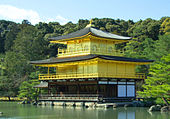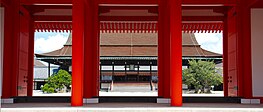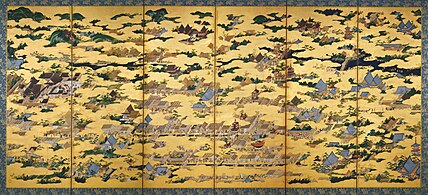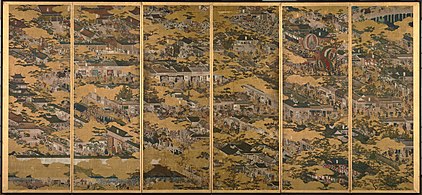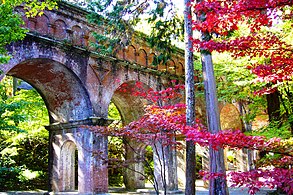
A | B | C | D | E | F | G | H | CH | I | J | K | L | M | N | O | P | Q | R | S | T | U | V | W | X | Y | Z | 0 | 1 | 2 | 3 | 4 | 5 | 6 | 7 | 8 | 9
Kyoto
京都市 | |
|---|---|
From top left: Kiyomizu-dera temple, Bamboo Forest of Arashiyama, Kinkaku-ji temple, Dry garden of Ryōan-ji, Honmaru-goden of Nijō Castle, Fushimi Inari-Taisha shrine, gate of Nanzen-ji, and Kyoto Imperial Palace complex | |
 | |
 Location of Kyoto in Kyoto Prefecture | |
| Coordinates: 35°0′42″N 135°46′6″E / 35.01167°N 135.76833°E | |
| Country | |
| Region | Kansai |
| Prefecture | Kyoto Prefecture |
| Founded | 794 |
| Government | |
| • Type | Mayor–council |
| • Body | Kyoto City Assembly |
| • Mayor | Kōji Matsui |
| Area | |
| • Designated city | 827.83 km2 (319.63 sq mi) |
| Highest elevation | 971 m (3,186 ft) |
| Lowest elevation | 9 m (30 ft) |
| Population (October 1, 2020)[1] | |
| • Designated city | 1,463,723 |
| • Rank | 9th, Japan |
| • Density | 1,800/km2 (4,600/sq mi) |
| • Metro | 3,783,014 |
| Time zone | UTC+9 (Japan Standard Time) |
| - Tree | Weeping Willow, Japanese Maple and Katsura |
| - Flower | Camellia, Azalea and Sugar Cherry |
| Website | city.kyoto.lg.jp |
| Kyoto | |||||||
|---|---|---|---|---|---|---|---|
"Kyoto" in kanji | |||||||
| Japanese name | |||||||
| Kanji | 京都 | ||||||
| Hiragana | きょうと | ||||||
| Katakana | キョウト | ||||||
| |||||||
Kyoto (/ˈkjoʊtoʊ/;[3] Japanese: 京都, Kyōto [kʲoꜜːto] ), officially Kyoto City (京都市, Kyōto-shi, [kʲoːtoꜜɕi] ), is the capital city of Kyoto Prefecture in the Kansai region of Japan's largest and most populous island of Honshu. As of 2020[update], the city had a population of 1.46 million, making it the ninth-most populous city in Japan. More than half (56.8%) of Kyoto Prefecture's population resides in the city. The city is the cultural anchor of the substantially larger Greater Kyoto, a metropolitan statistical area (MSA) home to a census-estimated 3.8 million people. It is also part of the even larger Keihanshin metropolitan area, along with Osaka and Kobe.
Kyoto is one of the oldest municipalities in Japan, having been chosen in 794 as the new seat of Japan's imperial court by Emperor Kanmu. The original city, named Heian-kyō, was arranged in accordance with traditional Chinese feng shui following the model of the ancient Chinese capitals of Chang'an and Luoyang. The emperors of Japan ruled from Kyoto in the following eleven centuries until 1869. It was the scene of several key events of the Muromachi period, Sengoku period, and the Boshin War, such as the Ōnin War, the Honnō-ji Incident, the Kinmon incident, and the Battle of Toba–Fushimi. The capital was relocated from Kyoto to Tokyo after the Meiji Restoration. The modern municipality of Kyoto was established in 1889. The city was spared from large-scale destruction during World War II and, as a result, its prewar cultural heritage has mostly been preserved.
Kyoto is considered the cultural capital of Japan and is a major tourist destination. The agency for cultural affairs of the national government is headquartered in the city. It is home to numerous Buddhist temples, Shinto shrines, palaces and gardens, some of which have been designated collectively as a World Heritage Site by UNESCO. Prominent landmarks include the Kyoto Imperial Palace, Kiyomizu-dera, Kinkaku-ji, Ginkaku-ji, and Kyoto Tower. The internationally renowned video game company Nintendo is based in Kyoto. Kyoto is also a center of higher learning in the country, and its institutions include Kyoto University, the second-oldest university in Japan.
Name
In Japanese, Kyoto was previously called Kyō (京), Miyako (都), Kyō no Miyako (京の都), and Keishi (京師). After becoming the capital of Japan at the start of the Heian period (794–1185), the city was often referred to as Heian-kyō (平安京, "Heian capital"), and late in the Heian period the city came to be widely referred to simply as "Kyōto" (京都, "capital city"). After the seat of the emperor was moved to the city of Edo and that city was renamed "Tōkyō" (東京, meaning "eastern capital"), Kyoto was briefly known as "Saikyō" (西京, meaning "western capital"). As the capital of Japan from 794 to 1868, Kyoto is sometimes called the thousand-year capital (千年の都).
Historically, foreign spellings for the city's name have included Kioto and Miaco or Meaco.[4][5]
History
Origins
Ample archeological evidence suggests human settlement in the area of Kyoto began as early as the Paleolithic period,[6] although not much published material is retained about human activity in the region before the 6th century, around which time the Shimogamo Shrine is believed to have been established.
During the 8th century, when powerful Buddhist clergy became involved in the affairs of the imperial government, Emperor Kanmu chose to relocate the capital in order to distance it from the clerical establishment in Nara. His last choice for the site was the village of Uda, in the Kadono district of Yamashiro Province.[7]
The new city, Heian-kyō (平安京, "tranquility and peace capital"), modeled after Chinese Tang dynasty capital Chang'an,[8] became the seat of Japan's imperial court in 794, beginning the Heian period of Japanese history. Although military rulers established their governments either in Kyoto (Muromachi shogunate) or in other cities such as Kamakura (Kamakura shogunate) and Edo (Tokugawa shogunate), Kyoto remained Japan's capital until the transfer of the imperial court to Tokyo in 1869 at the time of the Imperial Restoration.
Middle Ages
In the Sengoku period, the city suffered extensive destruction in the Ōnin War of 1467–1477, and did not really recover until the mid-16th century.[9] During the war, battles between samurai factions spilled into the streets, and came to involve court nobility (kuge) and religious factions as well. Nobles' mansions were transformed into fortresses, deep trenches dug throughout the city for defense and as firebreaks, and numerous buildings burned. The city has not seen such widespread destruction since.
In the late 16th century, Toyotomi Hideyoshi reconstructed the city by building new streets to double the number of north–south streets in central Kyoto, creating rectangle blocks superseding ancient square blocks. Toyotomi also built earthwork walls called odoi (御土居) encircling the city. Teramachi Street in central Kyoto is a Buddhist temple quarter where Toyotomi gathered temples in the city.
- Gallery
-
Rakuchū rakugai zu, a 16th-century depiction of central Kyoto including Gion Matsuri floats (center) and Kiyomizu-dera (upper right)
Early modern period
This section needs expansion. You can help by adding to it. (June 2024) |
Throughout the Edo period, the economy of the city flourished as one of three major cities in Japan, the others being Osaka and Edo. At the end of the period, the Hamaguri rebellion of 1864 burned down 28,000 houses in the city, which showed the rebels' dissatisfaction towards the Tokugawa Shogunate.[10]
- Gallery
-
Scenes in and around Kyoto (c. 1615)
-
Map of Heian-kyō, 1696
Modern period
This section needs expansion. You can help by adding to it. (June 2024) |
At the start of the Meiji period, the emperor's move from Kyoto to Tokyo in 1869 weakened the economy of Kyoto. The modern city of Kyoto was formed on April 1, 1889. The construction of Lake Biwa Canal in 1890 was one measure taken to revive the city. The population of the city exceeded one million in 1932.[11]
- Gallery
-
View of Kyoto from beside the Hondō of Kiyomizudera – 1870s[12]
-
Nanzenji aqueduct
Contemporary history
This section needs expansion. You can help by adding to it. (June 2024) |

There was some consideration by the United States of targeting Kyoto with an atomic bomb at the end of World War II because of the possibility that the city's importance was great enough that its loss might persuade Japan to surrender.[13] In the end, at the insistence of Henry L. Stimson, Secretary of War in the Roosevelt and Truman administrations, the city was removed from the list of targets and replaced by Nagasaki. The city was largely spared from conventional bombing as well, although small-scale air raids did result in casualties.[14] During the occupation, the U.S. Sixth Army and I Corps were headquartered in Kyoto.[15]
As a result, Kyoto is one of the few Japanese cities that still have an abundance of prewar buildings, such as the traditional townhouses known as machiya. However, modernization is continually breaking down traditional Kyoto in favor of newer architecture, such as the Kyōto Station complex.
Kyoto became a city designated by government ordinance on September 1, 1956. In 1994, 17 historic monuments in Kyoto were inscribed on the list as UNESCO World Heritage Sites. In 1997, Kyoto hosted the conference that resulted in the protocol on greenhouse gas emissions (United Nations Framework Convention on Climate Change).
Geography
Terrain
Kyoto is located in a valley, part of the Yamashiro (or Kyoto) Basin, in the eastern part of the mountainous region known as the Tamba highlands. The Yamashiro Basin is surrounded on three sides by mountains known as Higashiyama, Kitayama and Nishiyama, with a maximum height of approximately 1,000 meters (3,281 ft) above sea level. This interior positioning results in hot summers and cold winters. There are three rivers in the basin, the Uji River to the south, the Katsura River to the west, and the Kamo River to the east. Kyoto City takes up 17.9% of the land in Kyoto Prefecture and has a total area of 827.9 square kilometers (319.7 sq mi).
Kyoto sits atop a large natural water table that provides the city with ample freshwater wells. Due to large-scale urbanization, the amount of rain draining into the table is dwindling and wells across the area are drying at an increasing rate.
Climate
Kyoto has a humid subtropical climate (Köppen Cfa), featuring a marked seasonal variation in temperature and precipitation. Summers are hot and humid, but winters are relatively cold with occasional snowfall. Kyoto's rainy season begins around the middle of June and lasts until the end of July, yielding to a hot and sunny latter half of the summer. Kyoto, like most of the Pacific coast and central areas of Japan, is prone to typhoons during the summer and autumn.
| Climate data for Kyoto (1991−2020 normals, extremes 1880−present) | |||||||||||||
|---|---|---|---|---|---|---|---|---|---|---|---|---|---|
| Month | Jan | Feb | Mar | Apr | May | Jun | Jul | Aug | Sep | Oct | Nov | Dec | Year |
| Record high °C (°F) | 19.9 (67.8) |
22.9 (73.2) |
25.7 (78.3) |
30.7 (87.3) |
34.9 (94.8) |
36.8 (98.2) |
39.8 (103.6) |
39.8 (103.6) |
38.1 (100.6) |
33.6 (92.5) |
26.9 (80.4) |
22.8 (73.0) |
39.8 (103.6) |
| Mean daily maximum °C (°F) | 9.1 (48.4) |
10.0 (50.0) |
14.1 (57.4) |
20.1 (68.2) |
25.1 (77.2) |
28.1 (82.6) |
32.0 (89.6) |
33.7 (92.7) |
29.2 (84.6) |
23.4 (74.1) |
17.3 (63.1) |
11.6 (52.9) |
21.1 (70.0) |
| Daily mean °C (°F) | 4.8 (40.6) |
5.4 (41.7) |
8.8 (47.8) |
14.4 (57.9) |
19.5 (67.1) |
23.3 (73.9) |
27.3 (81.1) |
28.5 (83.3) |
24.4 (75.9) |
18.4 (65.1) |
12.5 (54.5) |
7.2 (45.0) |
16.2 (61.2) |
| Mean daily minimum °C (°F) | 1.5 (34.7) |
1.6 (34.9) |
4.3 (39.7) |
9.2 (48.6) |
14.5 (58.1) |
19.2 (66.6) |
23.6 (74.5) |
24.7 (76.5) |
20.7 (69.3) |
14.4 (57.9) |
8.4 (47.1) |
3.5 (38.3) |
12.1 (53.8) |
| Record low °C (°F) | −11.9 (10.6) |
−11.6 (11.1) |
−8.2 (17.2) |
−4.4 (24.1) |
−0.3 (31.5) |
4.9 (40.8) |
10.6 (51.1) |
11.8 (53.2) |
7.8 (46.0) |
0.2 (32.4) |
−4.4 (24.1) |
−9.4 (15.1) |
−11.9 (10.6) |
| Average precipitation mm (inches) | 53.3 (2.10) |
65.1 (2.56) |
106.2 (4.18) |
117.0 (4.61) |
151.4 (5.96) |
199.7 (7.86) |
223.6 (8.80) |
153.8 (6.06) |
178.5 (7.03) |
143.2 (5.64) |
73.9 (2.91) |
57.3 (2.26) |
1,522.9 (59.96) |
| Average snowfall cm (inches) | 5 (2.0) |
7 (2.8) |
1 (0.4) |
0 (0) |
0 (0) |
0 (0) |
0 (0) |
0 (0) |
0 (0) |
0 (0) Zdroj:https://en.wikipedia.org?pojem=Kyoto,_Kyoto Text je dostupný za podmienok Creative Commons Attribution/Share-Alike License 3.0 Unported; prípadne za ďalších podmienok. Podrobnejšie informácie nájdete na stránke Podmienky použitia.
Analytika
Antropológia Aplikované vedy Bibliometria Dejiny vedy Encyklopédie Filozofia vedy Forenzné vedy Humanitné vedy Knižničná veda Kryogenika Kryptológia Kulturológia Literárna veda Medzidisciplinárne oblasti Metódy kvantitatívnej analýzy Metavedy Metodika Text je dostupný za podmienok Creative
Commons Attribution/Share-Alike License 3.0 Unported; prípadne za ďalších
podmienok. www.astronomia.sk | www.biologia.sk | www.botanika.sk | www.dejiny.sk | www.economy.sk | www.elektrotechnika.sk | www.estetika.sk | www.farmakologia.sk | www.filozofia.sk | Fyzika | www.futurologia.sk | www.genetika.sk | www.chemia.sk | www.lingvistika.sk | www.politologia.sk | www.psychologia.sk | www.sexuologia.sk | www.sociologia.sk | www.veda.sk I www.zoologia.sk | |||



